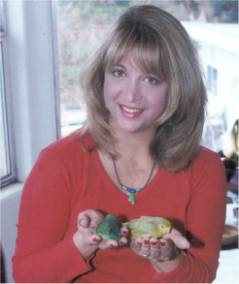Hello Sandee,
I recently lost my conure at 18 years old. This is the first time in my life I haven’t had a bird and we really miss the presence of a feathered friend. I am contemplating a pair of green rump parrotlets. Is it true they are the gentlest of the parrotlets? If I got them at a young age, would they continue to be close with each other? I knew someone who had a pair of Pacifics and the female decapitated the male so I just want to make sure that doesn’t happen. Also, do you have youngsters from different lines just in case they did breed at some point? It’s not a goal of mine (finding homes is a chore), but certainly a concern that any offspring would be healthy.
Thank you in advance,
Tiffany
Dear Tiffany:
Thank you so much for your email. I am so sorry to hear about the loss of your conure.
There is a big misconception about Green Rumps that they are ‘sweeter’ or ‘more gentle’ than Pacifics and that just isn’t true. They are very timid, very shy birds and many people misinterpret that shyness as being sweet or that they make better pets. Also, as a lifelong bird owner, I’m sure you must be aware that all birds – just like people – are individuals and while one can make generalizations about certain characteristics, the bottom line is that how a bird is imprinted, socialized and trained is a much better indicator of how a bird is going to behave as a pet. That being said, I do have to state that I am not taking reservations for Green Rumps anymore since my waiting list is more than a year long.
As for two birds staying close, that really isn’t something that happens with parrotlets. Parrotlets are either pets or breeders, not both. This is probably what happened with your friend’s Pacifics. You have two healthy adult well-fed birds of the opposite sex kept in a cage together and if they are not set up for breeding, then hormones get out of control and mate killing can happen. I also know that just because the bird was ‘decapitated’ it does not mean that the hen did it. If the dead bird’s feet were chewed up and there is blood all over the cage and perches, then the hen is the culprit. If not, the bird died of something else and the hen mutilated the body. Parrotlets often cannibalize a dead bird – this is an instinct that helps them survive in the wild, both to keep predators away and to consume energy. It’s not pretty but Mother Nature rarely is. It’s what has helped the species survive for millennia in very harsh conditions. In captivity, this instinct is not necessary and is one that often is very upsetting to owners but there are ways to prevent it. Pet parrotlets are best kept as single birds unless they are kept in separate cages. One bird will often become dominant over the other and ‘share’ is not a word in the parrotlet vocabulary. The dominant bird will keep the other from eating, perching, playing, etc., and while they may preen one another or sit next to each other on a perch (again, survival instincts but not ‘love’ or ‘affection’ as many people think) then injury or death can occur. That is why I always recommend that pet parrotlets be kept in separate cages.
I have bred parrotlets for almost 30 years and have written 3 books on them as well as give seminars on parrotlet care around the world. I have always sold unrelated birds to people regardless of whether or not they intend to breed them. I learned a long time ago that instinct is what governs birds so make sure that any pairs sold are unrelated, whether the birds are going to be pets or breeders.
Hope this helps!
Sincerely yours,
Sandee L. Molenda, C.A.S.
The Parrotlet Ranch, Owner, www.parrotletranch.com
Join the International Parrotlet Society, – the World’s Largest and Oldest Parrotlet Organization www.internationalparrotletsociety.org
A Chattering Bird Builds No Nest.
Camaroonian Phrase
Friday, May 27, 2011
Green Rump Pairs
Subscribe to:
Post Comments (Atom)




No comments:
Post a Comment
Note: Only a member of this blog may post a comment.